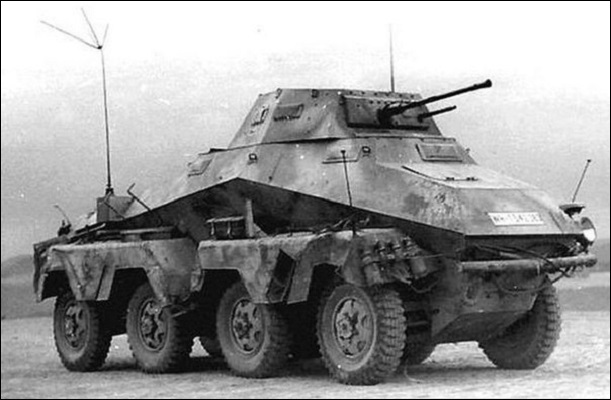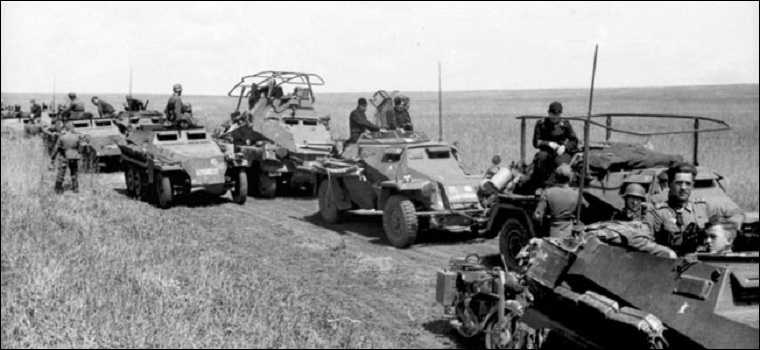The Aufklärungs-Abteilung (motorisiert)
was the divisional reconnaissance battalion of panzer
and motorized infantry divisions. In early 1940 those
belonging to panzer divisions were
redesignated as Panzer-Aufklärungs-Abteilungen,
and when the motorized infantry divisions became panzer
grenadier divisions in late 1942, their reconnaissance
battalions were similarly retitled.
● ● ●
In the wartime German Army
reconnaissance was a sophisticated and complex
undertaking, and the reconnaissance battalion was a key
component of all divisions. This was especially so for the
mechanized mobile divisions, and their reconnaissance
battalions were not merely scout units.
The tactical doctrine governing the
employment of the reconnaissance battalion was that it
should fight for information. Locating the enemy was only a
first step. The reconnaissance battalion was then expected
to develop the situation by forcing the enemy to
deploy, revealing his strength and intentions. This was done
by simulating a full-scale attack, both to acquire and
report information, and to buy time. Thus the reconnaissance
battalion had to have sufficient strength and firepower to
make its attack appear plausible, and reliable means of
communication with the division headquarters. These
considerations governed its original organization and its
evolution from 1939 to 1945.
From 1939 to 1942 the
motorized reconnaissance battalion of the
panzer divisions and
motorized infantry divisions had the organization depicted
in the diagram below. Not all battalions were exactly alike
and early on those of the panzer divisions were larger than
those of the motorized infantry divisions. By the end of
1941, however, a standard organization had been adopted for
both types of divisions. The battalion headquarters company
and the armored car companies were well equipped with
radios, including long-range models to facilitate
communications with higher headquarters. The armored car
platoons had four-, six- and eight-wheeled armored cars
armed with machine guns and 20mm automatic cannons.
Typically, these platoons would lead the way, probing for
the enemy, with the motorcycle infantry company and the
heavy company with its towed antitank and infantry guns in
close support, ready to go into action when contact was
made.
The wheeled armored cars,
motorcycles and trucks with which the armored
reconnaissance battalion was equipped proved adequate for
operations in areas with a developed road network, such as
France. But in Eastern Europe and European Russia, where
good roads were few, they were less effective due to their
limited off-road mobility. The first year of the campaign in
Russia also disclosed that the battalion’s firepower was
inadequate. In particular, the heavy company’s 37mm antitank
guns were ineffective against the Red Army’s T-34 and KV
tanks. The obvious solution to the mobility problem was to
equip the reconnaissance battalions with tracked and
half-tracked vehicles. Firepower was boosted by providing
more and heavier support weapons.

The Sd Kfz 232 heavy armored car (World
War Photos)
Unlike the US and British armies,
the German Army never equipped its motorized reconnaissance battalions
with light tanks. Instead, the SPW 250 light armored
halftrack was modified by the addition of a turret identical
to that of the Sd Kfz 222 armored car, mounting a 20mm
cannon and a coaxial machine gun. The SPW 250 was also
modified to serve as an armored command vehicle, an armored
radio vehicle and an armored support vehicle in several
configurations. These SPW 250s equipped the new armored car
(halftrack) and armored reconnaissance companies created in
late 1942. There were never enough of them, however,
completely to replace wheeled armored cars.
Nonetheless, the 1942 armored
reconnaissance battalion (as it was by then designated) was considerably larger and more
heavily armed than its predecessor. The motorcycle
infantry company was deleted and replaced by two armored
reconnaissance companies with three rifle platoons and a
heavy weapons platoon (mortars and heavy machine guns) all
carried in SPW 250s. There were two armored car companies,
one wheeled and one halftrack. The armored heavy company had
the larger SPW 251 armored halftrack for its self-propelled
and towed infantry and antitank gun companies. The battalion
headquarters included a platoon with six heavy armored cars,
armed with 75mm infantry guns.
But thanks to equipment shortages,
there were many variations from this desired standard. Only
the 1st Panzer Division had the full armored reconnaissance
battalion as depicted below. Some battalions had only one
armored reconnaissance company, sometimes supplemented by a
motorcycle infantry company or a light motorized company
with Volkswagen field cars. In many battalions, the heavy
company was motorized, equipped with trucks instead of
halftracks. The reconnaissance battalion of the 13th Panzer
Division, for example, had one armored car company
(wheeled), one armored reconnaissance company, two light
motorized reconnaissance companies and a motorized heavy
company.

Vehicles and troops of a reconnaissance
battalion in Russia, 1943 (Photo: Bundesarchiv)
In late 1944 the standard armored
reconnaissance battalion had one wheeled and one halftrack
armored car company, one armored reconnaissance company and
an armored heavy company. Once again, however, equipment
shortages dictated many deviations from the authorized
organization. And even when it could be achieved, combat
losses quickly reduced the battalion’s strength.
In addition to its primary role,
the armored reconnaissance battalion was frequently employed as a
mobile reserve force, particularly when its parent division
was on the defensive. When so tasked it was usually
organized as a battle group (Kampfgruppe) with
additional units attached, e.g. a tank company or an assault
gun battery. This practice of cross-attaching divisional
sub-units to create task forces for specific mission was a
standard practice of the German Army.
In the postwar period, most major
armies adopted and elaborated upon the wartime German reconnaissance
unit model. The
US Army, for example, evolved the armored cavalry regiment,
in effect a mechanized brigade with its own tank, artillery
and helicopter support.
● ● ●